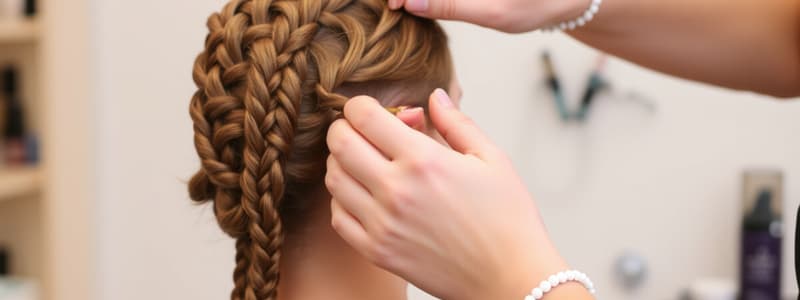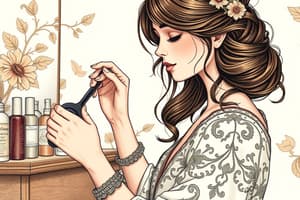Podcast
Questions and Answers
Why is it important to position your equipment for ease of use when plaiting hair?
Why is it important to position your equipment for ease of use when plaiting hair?
- To work in a methodical manner (correct)
- To save time (correct)
- Prevents fatigue and muscle injury (correct)
- Looks professional (correct)
Why is it important to check that the client has no discomfort when carrying out a plaiting or twisting service?
Why is it important to check that the client has no discomfort when carrying out a plaiting or twisting service?
To avoid injury to the client
What could happen to the hair if discomfort is not checked during plaiting or twisting?
What could happen to the hair if discomfort is not checked during plaiting or twisting?
Damage to the hair resulting in breakage
What is a consequence of excessive tension on the hair?
What is a consequence of excessive tension on the hair?
A vertical two strand twist on an elongated head would __________.
A vertical two strand twist on an elongated head would __________.
What is the effect of multiple cornrows on dense, wavy hair?
What is the effect of multiple cornrows on dense, wavy hair?
What is an effect of a single fishtail at the back of the head on short, very curly hair?
What is an effect of a single fishtail at the back of the head on short, very curly hair?
What is the effect of flat twists around the head on long, fine hair?
What is the effect of flat twists around the head on long, fine hair?
What happens to the hair structure when plaiting or twisting hair when damp?
What happens to the hair structure when plaiting or twisting hair when damp?
What is an effect of plaiting or twisting hair when damp?
What is an effect of plaiting or twisting hair when damp?
What is a method used to secure completed plaits and twists?
What is a method used to secure completed plaits and twists?
When should hairspray be used in the plaiting and twisting service?
When should hairspray be used in the plaiting and twisting service?
Why would you use gel when plaiting and twisting the hair?
Why would you use gel when plaiting and twisting the hair?
Why is it important to follow manufacturer's instructions when using tools and equipment?
Why is it important to follow manufacturer's instructions when using tools and equipment?
What could happen if manufacturer's instructions are not followed?
What could happen if manufacturer's instructions are not followed?
Flashcards are hidden until you start studying
Study Notes
Importance of Equipment Positioning
- Proper equipment positioning enhances efficiency and saves time during plaiting.
- A methodical approach improves workflow and organization during hairstyling.
- Ergonomically placing tools reduces fatigue and risk of muscle injuries.
- Professional presentation is achieved through well-placed equipment.
Client Comfort and Safety
- Checking client comfort prevents potential injuries during plaiting or twisting services.
- Ensures hair health by avoiding damage leading to breakage.
- Prevents scalp issues such as traction alopecia, which is caused by excessive tension.
Hair Style Effects Based on Hair Type and Length
- Vertical two-strand twists can elongate facial appearance, often deemed unflattering for certain face shapes.
- Multiple cornrows suit dense, wavy hair due to its strength and volume.
- A single fishtail braid may be ineffective on short, very curly hair due to insufficient hair length.
- Flat twists may expose the scalp when done on long, fine hair, increasing the risk of traction alopecia.
Effects of Damp Hair on Structure
- Damp hair considered in its natural, unstretched state (Alpha Keratin) before styling.
- While damp, hair bonds soften, allowing it to conform to the shape of the twist or plait during drying.
- Drying hair under tension results in a stretched state (Beta Keratin) post-plaiting.
Consequences of Excessive Tension
- Excessive tension on hair can lead to traction alopecia, a form of hair loss.
- Clients may experience discomfort from too much pulling during styling.
- Increased tension can cause potential hair breakage.
Securing Plaits and Twists
- Common methods for securing hairstyles include using covered bands, hair grips, and ribbons.
Use of Finishing Products
- Hairspray is recommended at the end of the styling process to maintain the style and minimize flyaway hairs.
- Serum is applied during and at the end of service to add shine and definition while controlling frizz.
- Gel is used throughout the styling process to hold the hairstyle and shape hair as desired.
Following Manufacturer's Instructions
- Adhering to manufacturer guidelines prevents injuries to the stylist and clients.
- Following instructions optimizes results during styling, ensuring the desired outcome.
- Proper usage of tools protects the hair and scalp from potential damage.
Studying That Suits You
Use AI to generate personalized quizzes and flashcards to suit your learning preferences.




